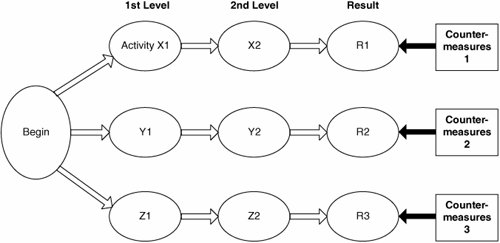Process Decision Program Chart (PDPC)
| PDPC is like a tree diagram that seeks to identify all the things that can possibly go wrong and the necessary countermeasures to prevent or correct them. It has its roots in operations research and has been developed as a preventive and corrective tool in quality control and product and process design. PDPC lists undesirable events and corresponding contingency measures. Its power lies not only in anticipating upcoming risk conditions but also in planning to respond adequately to such conditions. You should use it when you have serious concerns about the likelihood of adverse and unpredictable outcomes. PDPC has no definite structural rules. Mizuno suggests the following guidelines:[16]
PDPC is similar in appearance to the tree diagram, except that it is dynamic and characterized by flow lines chronologically (see Figure 7.6). The steps for constructing a PDPC are as follows:
Figure 7.6. A Process Decision Program Chart PDPC is essentially a method to resolve system failures. But unlike the other well-known methods, such as Failure Modes and Effects Analysis and Fault Tree Analysis (see Chapter 13), PDPC can reveal not only logical phenomena but also those expressed in light of new ideas. Used in addition to these methods, PDPC enhances reliability markedly.[18] |
EAN: 2147483647
Pages: 394